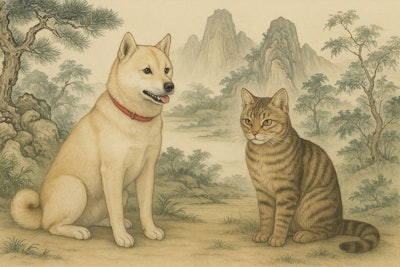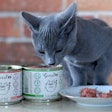
In 2024, China’s pet goods market reached US$41.9 billion CNY302 billion) with pet food making up 52.8% of the total, according to a U.S. Department of Agriculture Foreign Agricultural Service report. This figure represents an increase of 7.5% compared with 2023.
"In 2024, the market size of China’s pet food reached US$22.2 billion (CNY159.5 billion), with a year-on-year increase of 9.2%," USDA market analysts wrote. "From 2013 to 2024, the compound annual growth rate of China’s pet food market was 22.4%, far higher than the global average growth rate. However, the current market penetration rate in China is around 20%, compared to other developed countries in Europe and North America which has over a 90% penetration rate."
Despite rising Chinese domestic pet food manufacturing capacity and competition from international markets, the United States remained the Middle Kingdom’s top pet food supplier. U.S. pet food exports China accounted for more than 69 percent of the market share during the first 10 months of 2024.
Spending per pet increased modestly in 2024. Average annual consumption rose to US$411 (CNY2,961) for dogs, up 3%, and US$281 (CNY2,020) for cats, up 4.9%. While these figures indicated growth, they also suggested a stabilization in individual spending patterns.
Pet owner demographics
China had approximately 106 million pet owners in 2023. Larger cities accounted for 29% of this population, while medium and small cities made up 30%. The pet-owning demographic was largely composed of individuals born after 1980, with the post-1990s cohort representing 41.2% of pet owners. These generational groups value pet companionship and were more inclined to invest in premium goods and services.
China’s cat product market grew 10.7% in 2024, compared to 4.6% for the dog segment. The pet population reached 124.1 million, 71.5 million cats and 52.6 million dogs, marking a continued shift toward feline companions. The trend is influenced by urban lifestyles, with young consumers favoring the lower maintenance needs of cats due to long work hours and limited space. In 2023, cat food sales reached US$9.8 billion (CNY71 billion), up 7.6%, while dog food reached US$10.3 billion (CNY74.8 billion), up 3.9%. Cat food consumption surpassed dog food in 2022 and continues to gain momentum.
Pet food performance by species and format
Pet food, including dry, semi-moist, snacks, and supplements, accounted for 56.1% of total pet market spending over the past three years. In 2024, China’s pet food market grew 9.2% yearly to US$22.2 billion (159.5 billion yuan). Between 2013 and 2024, the sector maintained a compound annual growth rate of 22.4%, well above the global average, though market penetration remains low at approximately 20% compared to over 90% in Western markets.
Consumers showed growing interest in baked dry food, freeze-dried and fresh pet foods in 2024. Dog owners especially favored baked dry and wet staple foods, while cat owners increased purchases of baked dry and fresh food. Preference for freeze-dried and extruded foods among cat owners declined. Online platforms dominate pet food sales. Taobao/Tmall and JD.com remain the top e-commerce destinations, while usage of live-stream platforms such as TikTok grew significantly in 2023.
Domestic vs. imported pet products
China has 200 certified pet food manufacturers with an annual capacity of 1.12 million tons. Hebei and Shandong lead production, accounting for over 60% of national output. Domestic brands have made gains in the cat food market and in categories like snacks and nutritional products.
- Among dog owners:
- 47% have no brand preference
- 27% prefer Chinese brands
- 18% prefer imported brands
- Among cat owners:
- 48% have no brand preference
- 28% prefer Chinese brands
- 19% prefer imported brands
The preference for Chinese brands is rising, particularly among cat owners.
The market is polarized between high-end and low-price segments. While high-end consumption remains stable, competition has intensified in the budget segment, driving prices down. Some mid-tier consumers are trading up to premium products due to growing awareness of pet nutrition, while others are opting for improved low-price options.
Regional differences in Chinese pet food market
- East China (36% of consumption): Strong demand for high-end products due to affluence and dense pet ownership.
- West China (17%): Emerging market with young, increasingly affluent consumers.
- South China (15%): Cat population growing due to climate-related dog ownership challenges; exotic pets also popular.
- North China: Pet food production hub, especially Hebei and Shandong; Beijing leads in pet spending.
- Northeast China: Liaoning Province is China’s pet breeding center, supplying 70% of pet dogs and cats—ideal for brands targeting breeders.
Pet food imports and performance
The U.S. remained China’s top pet food exporter in 2023 and 2024. As of July 2024, 114 U.S. facilities were registered with China’s General Administration of Customs (GACC), including 19 new or renewed registrations since January 2023. Additionally, China’s Ministry of Agriculture and Rural Affairs (MARA) approved 186 SKUs of U.S. pet foods in four rounds of notices—49% of all approvals during that period.
Despite strong U.S. performance, total pet food imports into China declined 17% year over year to US$427.24 million in the first ten months of 2024. This decline reflects the rapid growth of China’s domestic pet food sector and post-pandemic consumption adjustments. According to U.S. Census Bureau data, U.S. exports of pet food to China totaled US$236.9 million in the first nine months of 2024, up 9% year over year. Baked and freeze-dried products represent a growing share, aligning with Chinese consumer preferences for premium quality.
China’s pet food market in 2024 continued to demonstrate strong growth amid shifting demographics, evolving consumer preferences and increasing domestic competition. While U.S. exporters maintain a lead, the rise of Chinese brands and maturing market segments suggest that success in China will depend on innovation, adaptability, and alignment with local trends.

















